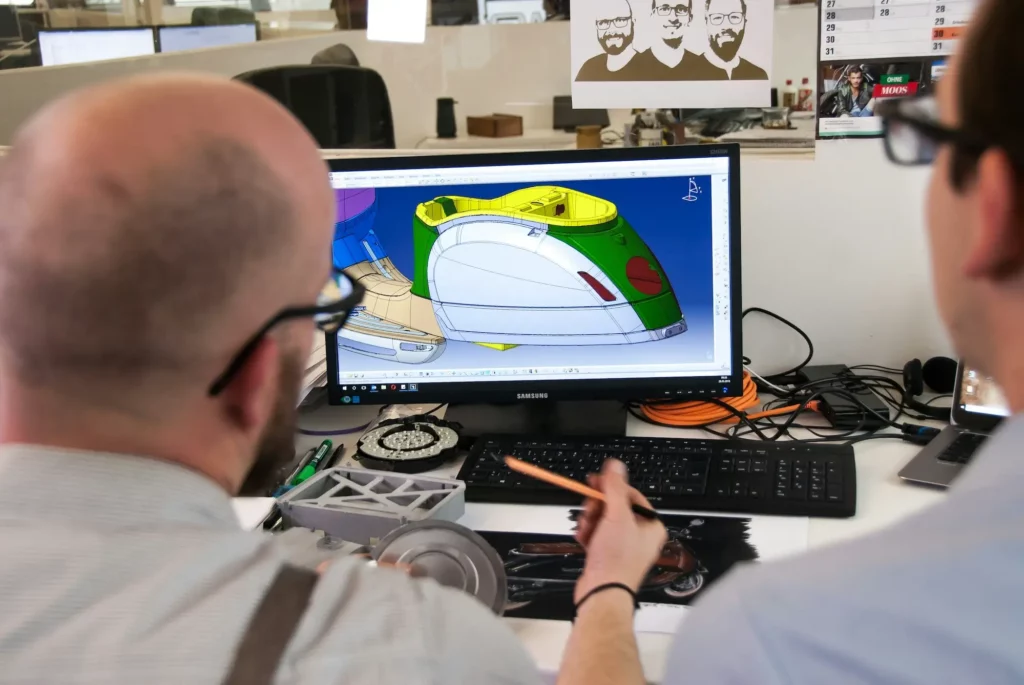Good design heavily depends on teamwork. When designers, project managers, and other team members can share ideas in real time, projects move forward faster and with fewer mistakes.
Design collaboration tools give teams a shared space to brainstorm, review files, and turn feedback into action without the back-and-forth that slows progress. These tools also make it easier to stay organized and keep everyone aligned.
In this article, we’ll introduce you to 6 design collaboration platforms that can provide structure, improve communication, and help your teams focus on the work that matters most.
6 Best Online Collaboration Tools Summary
Here’s a summary table of our favorite tools for design collaboration:
| Tool | Best for | Price | Features for Design Collaboration |
| CADchat | Product teams, engineers, manufacturers, and stakeholders reviewing CAD files | Free plan available, paid plan starts at $17 per member | Live CAD model reviewsAsynchronous feedbackPersistent digital workspacesVersion control |
| Asana | Design teams, project managers, marketing, and other departments tracking design projects | Free plan available, paid starts at $13.49/user per month | Centralized platform for tasks and design filesTemplates for design projectsSeamless integrations with 300+ appsMobile apps for collaboration anywhere |
| FigJam | Designers, product teams, and cross-functional teams brainstorming and mapping workflows | Free plan available, Starter plan starts at $20 for full access | Brainstorming tools with sticky notes and stampsDiagramming for workflowsMeeting and workshop facilitationAgile workflows for sprints and retros |
| Creately | Teams designing workflows, software systems, and documenting processes visually | Free plan available, paid starts at $8/user per month | Infinite canvas for brainstormingAI-powered diagramming1,000+ ready-made templatesReal-time and async collaboration |
| Webflow | Design and marketing teams building websites without heavy developer reliance | Free starter plan available, paid starts at $18/month | Visual design canvas for no-code site buildingBuilt-in CMS for content updatesCollaboration workflows with roles and approvalsAI and optimization tools |
| Notion | Teams needing centralized knowledge-sharing across design, product, engineering, and marketing | Free plan available, paid starts at $12/user per month | AI meeting notes for accurate documentationEnterprise search across systemsProject tracking for design tasksCustomizable docs and wikis |
What Are Design Collaboration Tools?
Design collaboration tools are digital platforms that help design teams share ideas, give feedback, and move projects forward. These tools make it easier for designers to take a first idea, turn it into a concept, and bring that concept to life.
They allow teams to create designs together, focus on big ideas, and keep the design process smooth from start to finish.
For designers, the best tools support creativity by giving space to sketch, write, and build on an idea. They allow a team to collaborate in real time, add comments, and refine concepts. This way, teams don’t just share files but also share the thought process behind each design step.
These collaborative digital tools also improve the feedback loop. Designers can present ideas quickly, get input, and make changes without delays, which makes the process more open. Every team member can contribute to the project and help create something better.
Bring your entire product team into one collaborative workspace. Contact CADchat today.
6 Design Collaboration Tools You Should Check Out
Your team needs the right tools to share ideas, give feedback, and keep projects moving smoothly.
From brainstorming early concepts to reviewing final prototypes, these six platforms make collaboration easier and help teams focus on what really matters.
1. CADchat for Smooth CAD Collaboration
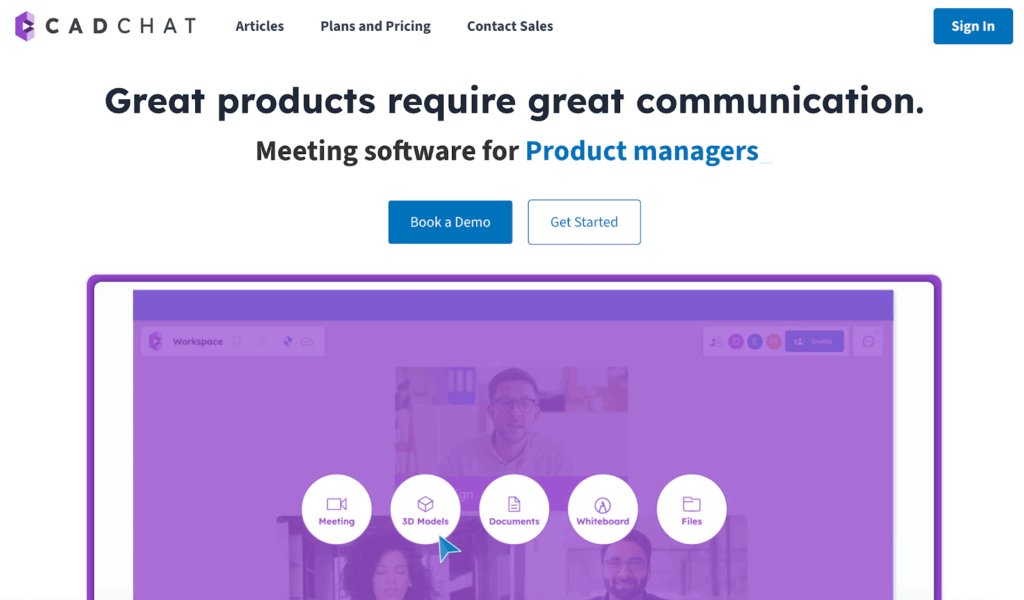
CADchat is a cloud-based meeting platform that makes design collaboration with CAD files simple and clear. It is built for product teams that include engineers, manufacturers, and other departments that need to stay connected during the design process.
No more endless emails or confusing file versions, CADchat gives teams one space to share ideas, review prototypes, and make faster decisions.
This CAD design review tool supports both real-time and anytime collaboration. Engineers can open CAD files with their team, stakeholders can leave comments on interactive prototypes, and clients can check designs without needing special CAD software.
Key Features
- Live CAD model reviews – Teams can open and edit 2D and 3D CAD models together in real time without screen sharing or file conversions
- Instant manufacturability feedback – Engineers and suppliers can flag issues and suggest fixes during live 3D CAD reviews, reducing delays and costly changes
- Non-technical accessibility – Stakeholders outside of engineering can view models and give feedback without needing CAD expertise
- Persistent digital workspaces – All files, comments, and decisions stay organized in one place, so nothing gets lost
- Version control and tracking – Works with all major CAD file formats and keeps every design updated and logged
- Asynchronous reviews – Team members can leave threaded comments on CAD models at any time, making collaboration easier across time zones
- Clear change history – Every decision, edit, and piece of feedback is logged, giving teams a full record of design progress
Keep everyone involved, no matter where they work. See how it works with a CADchat demo.
CADchat Pricing
CADchat keeps its pricing simple with three options. The Free plan costs nothing and gives you unlimited team members, video meetings up to 40 minutes, and spaces that last for 7 days.
If you want more flexibility, the Pro plan is $17 per member each month when billed annually, or $19 if you pay monthly.
With Pro, you get everything in the free plan plus unlimited meeting time, unlimited storage, and spaces that never expire.
For bigger teams with custom needs, there’s the Enterprise plan, which includes all Pro features and adds custom pricing built to grow with your workflow.
Stay aligned across time zones with 24/7 collaboration in CADchat. Get started today!
2. Asana for Task and Project Management
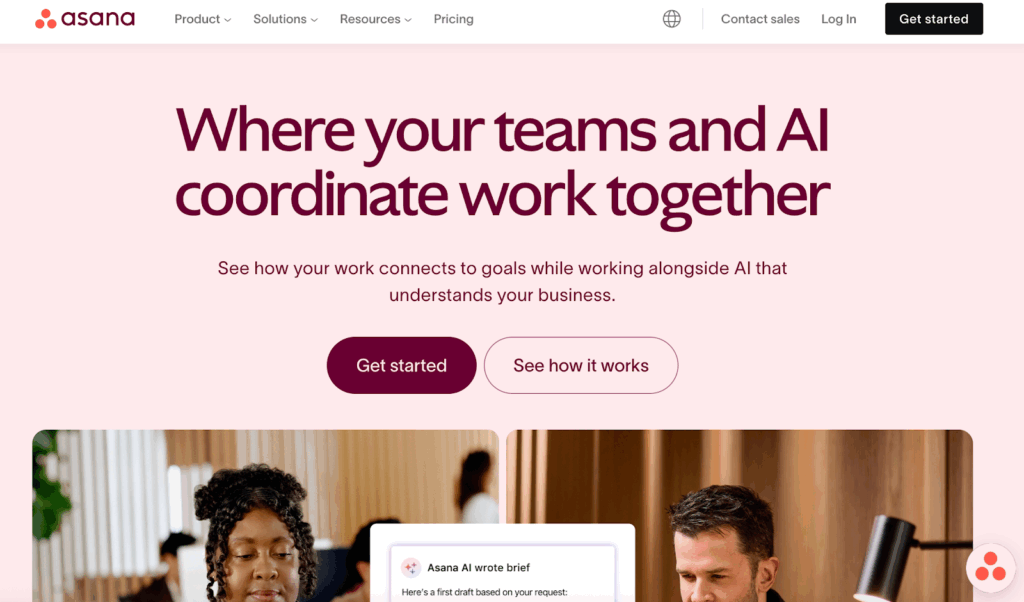
Source: asana.com
Asana is one of the most popular project management tools that also works well for design collaboration. It gives design teams a centralized platform to manage design projects, connect design systems, and keep design files organized.
Your team members can assign tasks, track progress, and collaborate in real time, whether on desktop or through mobile apps. With templates and seamless integration to over 300 apps, Asana makes project collaboration simple across departments.
Your design project moves faster because teams can set up workflows quickly, align work with company goals, and keep every design system connected.
Key Features
- Centralized platform – Keeps tasks, design files, and feedback in one place so design projects stay organized
- Templates for design projects – Offers ready-to-use templates to set up design systems and workflows quickly
- Seamless integration – Connects with over 300 apps, allowing teams to link design files and tools directly into Asana
- Mobile apps – Lets team members review, track, and collaborate on design projects from anywhere
- Goal and task management – Links design projects to company goals, keeping teams aligned and focused on outcomes
Asana Pricing
Asana offers different pricing plans based on team size and needs. The Personal plan is free and supports up to 10 people with basic project management features.
The Starter plan costs $13.49 per user each month and adds tools like timelines, workflow builder, and custom templates.
The Advanced plan is $30.49 per user each month and includes features such as goals, portfolios, workload, approvals, and native time tracking.
For larger companies, the Enterprise and Enterprise+ plans provide advanced controls, compliance options, and added security, but pricing is only available through sales.
3. FigJam for Visualizing the Design Process
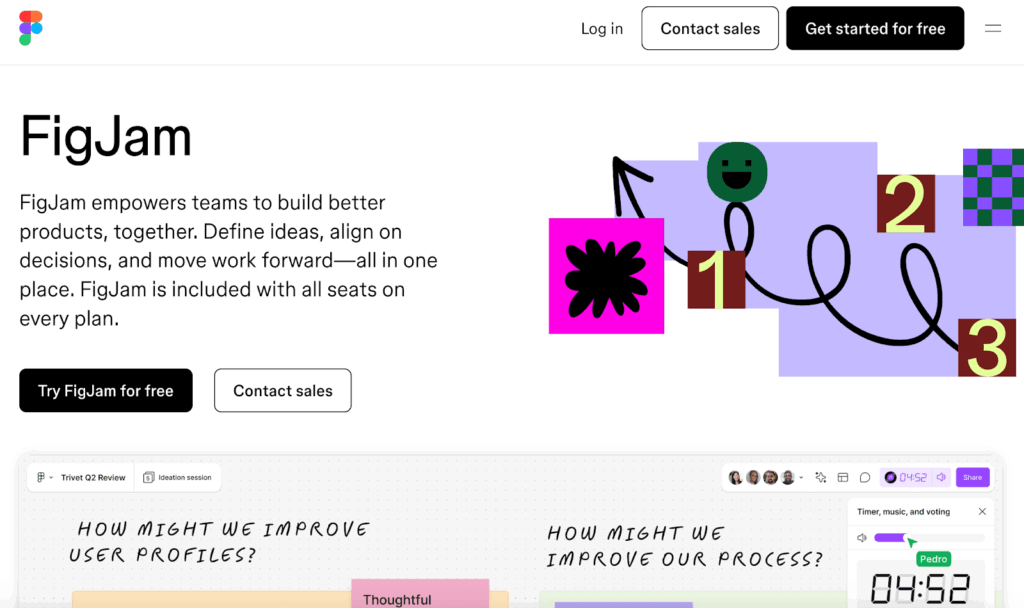
Source: figjam.com
FigJam is a collaboration tool that helps teams bring ideas to life while designing projects. It gives everyone a shared space for creating diagrams, brainstorming, and documenting workflows.
This tool helps boost your team’s productivity by keeping documentation, data, and conversations in one place. Teams can streamline communication, invite others to contribute, and make decisions faster.
With useful features and flexible workflows, it supports creating both quick brainstorming sessions and detailed project planning.
Key Features
- Brainstorming tools – Use sticky notes, stamps, and widgets to capture and expand on ideas in real time
- Diagramming support – Build flows, systems, and processes with shapes and connectors that snap neatly into place
- Meeting and workshop features – Run team sessions with tools like timers, voting, and fun interactive widgets to keep participants engaged
- Agile workflows – Support stand-ups, retros, and sprint planning with boards and templates designed for product teams
- Templates library – Access over 300 templates for kickoffs, retrospectives, journey maps, and more to keep projects moving quickly
FigJam Pricing
FigJam offers four pricing tiers. The Starter plan is free and great for personal use, with unlimited drafts, templates, and basic file inspection.
The Professional plan is for small teams, with seats at $5 for collaborators, $15 for developers, and $20 for full access. It includes unlimited files, shared libraries, advanced prototyping, and 3,000 monthly AI credits for full seats.
The Organization plan costs $25 for developers and $55 for full seats, adding unlimited teams, admin tools, and 3,500 AI credits.
At the top, the Enterprise plan is $35 for developers and $90 for full seats, with advanced features like custom workspaces, APIs, SCIM management, and 4,250 AI credits.
4. Creately for Large-Scale AI Diagrams
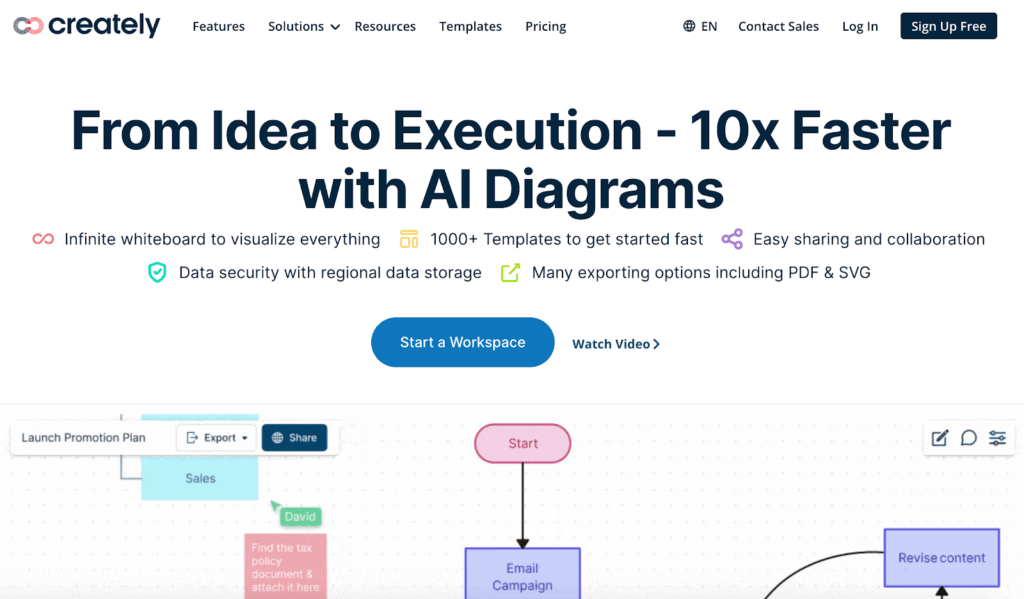
Source: creately.com
Creately is a platform that combines diagramming, whiteboarding, and task tracking to help teams manage design work in one place. It comes with features like flowcharts, wireframes, and mind maps that make it easier to turn ideas into clear visuals.
With AI tools built in, teams can enhance their brainstorming sessions, speed up design work, and make progress without losing context.
Creately gives everyone a shared sense of direction. Designers and managers can work together in real time or asynchronously, making it simple to add feedback, refine concepts, and keep projects moving.
Key Features
- Infinite visual canvas – Gives teams a flexible space to brainstorm, sketch, and map out projects together in real time
- AI-powered diagramming – Lets users generate flowcharts, wireframes, and other visuals from simple prompts, speeding up the design process
- Large template library – Offers 1,000+ templates for customer journeys, workflows, retrospectives, and more, so teams don’t have to start from scratch
- Real-time and async collaboration – Supports both live sessions and asynchronous input, keeping everyone aligned even across time zones
- Data-linked visuals – Connect diagrams to live data, making it easy to keep documentation, workflows, and updates accurate and connected
Creately Pricing
Creately has four main pricing options. The Free plan includes unlimited canvases and collaborators, but each canvas is limited to 45 items, making it best for simple work.
The Personal plan, at $8 per user each month, raises the limit to 1,000 items per canvas and adds premium templates, AI diagrams, and 30-day version history.
The Team plan, also $8 per user each month, is built for collaboration, offering 1,500 items per canvas, advanced sharing, multiple users, and chat support.
For larger groups, the Business plan is $149 per month for unlimited users and expands to 3,000 items per canvas, custom templates, project management tools, and a dedicated success manager.
5. Webflow for No-Code Website Design Collaboration
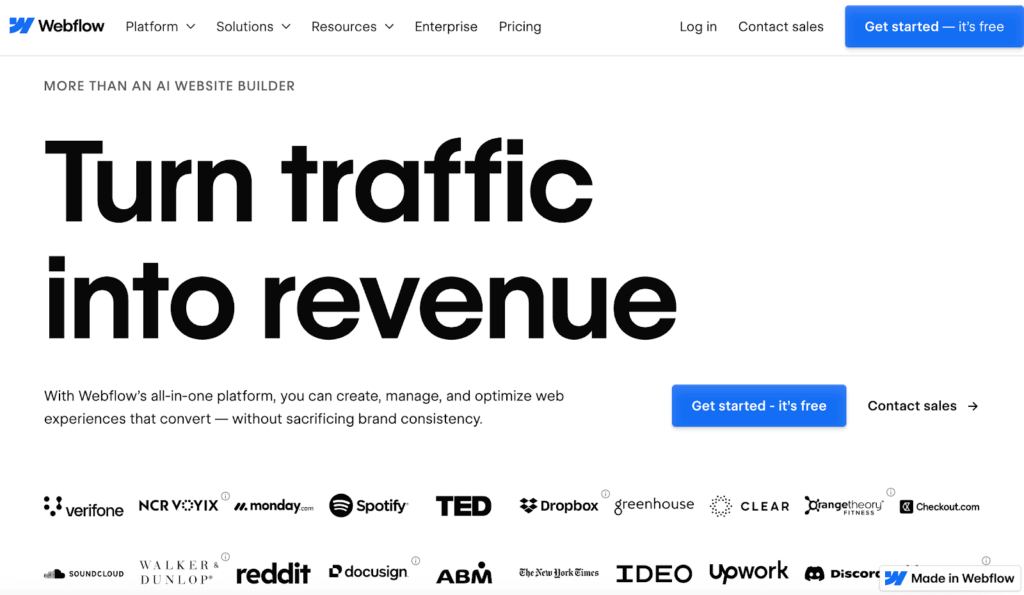
Source: webflow.com
Webflow is a no-code software that helps teams design, build, and manage websites without depending on developers for every change. It gives designers a visual canvas to create, while marketers can update content through the built-in CMS.
Webflow brings clarity to projects by combining design, marketing, and content management in one place.
With features like AI-driven optimization, SEO tools, and seamless integrations, Webflow helps teams move faster while still keeping flexibility for developers when advanced customization is needed.
Key Features
- Visual design canvas – Lets designers build pages directly without coding, while still generating clean code in the background
- Built-in CMS – Allows marketing and content teams to write, edit, and publish pages without developer support
- Collaboration workflows – Provides roles, permissions, and approvals so the company can review and manage work together
- AI and optimization tools – Supports A/B testing, SEO improvements, and personalization to boost project results
- Seamless integrations – Connects with apps and APIs to link Webflow with the rest of your software stack
Webflow Pricing
Webflow’s site plans are priced monthly and scale with the needs of each project. The Basic plan costs $18 per month and is best for simple sites like portfolios or landing pages, with up to 150 pages and no CMS.
The CMS plan is $29 per month and adds 20 CMS collections, 2,000 items, site search, and more bandwidth, making it suitable for blogs or marketing sites.
For larger projects, the Business plan is $49 per month, offering 300 pages, 40 CMS collections, 10,000 items, and higher bandwidth for high-traffic sites.
Companies with complex requirements can choose the Enterprise plan, which offers advanced collaboration, enterprise-level security, and dedicated support, with pricing available through sales.
6. Notion for Knowledge-Sharing
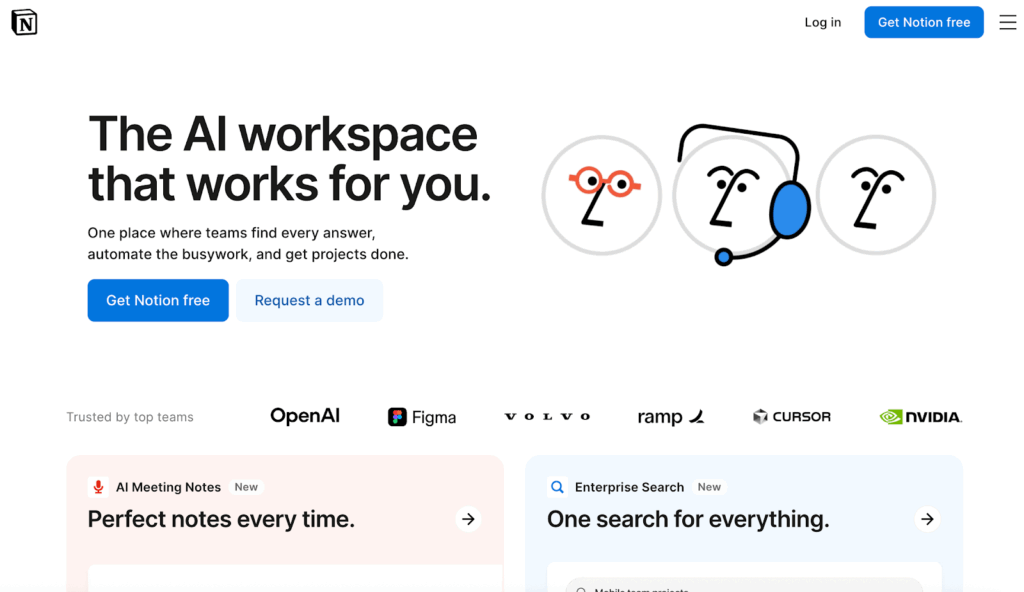
Source: notion.com
Notion works as an AI-powered workspace where teams can share knowledge, organize projects, and stay aligned. It helps teams track tasks, document processes, and communicate in one place instead of switching between multiple systems.
With AI built in, Notion can assist by summarizing notes, generating insights, and helping teams stay focused on what matters.
You can also connect existing tools through integrations with Slack, Google Drive, Jira, and more. This creates one hub where teams can manage projects, share updates, and capture insights, all while keeping workflows clear and easy to follow.
Key Features
- AI meeting notes – Automatically assist teams by creating accurate summaries from conversations
- Enterprise search – Find knowledge, files, and insights across different systems with one search
- Project tracking – Helps teams organize and track tasks, deadlines, and goals in a single workspace
- Customizable docs and wikis – Centralize documentation so teams can share updates and communicate clearly
- Wide integrations – Connects with apps like Slack, GitHub, and Google Drive to keep all work linked in one platform
Notion Pricing
Notion’s pricing is set up to support individuals and companies of all sizes. The Free plan costs nothing and is designed for personal use, offering databases, subtasks, Notion Calendar, Notion Mail, and a trial of Notion AI.
The Plus plan is $12 per member each month and adds unlimited file uploads, custom forms, custom sites, and basic integrations for small teams.
The Business plan, at $24 per member each month, is recommended for growing companies and includes private teamspaces, premium integrations, conditional forms, and advanced AI features like enterprise search and meeting notes.
For larger organizations, the Enterprise plan includes advanced security, user provisioning, compliance tools, and custom integrations, with pricing available through sales.
CADchat: Collaboration Tool Built for Product Design Teams
If your team works with CAD files, you know how much miscommunication can slow down projects. CADchat brings everyone together in one space so product design teams can focus on what really matters.
CADchat is built for innovation, giving engineers, manufacturers, and stakeholders the ability to review prototypes and solve problems in real time. Whether your team is working side by side or spread across time zones, CADchat keeps everyone connected and ready to contribute.
The design process is already complex, so your collaboration tool should make things easier, not harder.
With CADchat, your team gets a simple way to work together, share ideas, and make decisions that move projects forward.
FAQs About Design Collaboration Tools
Is Canva a collaborative tool?
Yes, Canva is a collaborative tool. You can invite others to edit designs in real time, leave comments, and work together on the same project. It’s simple to use for teams who want to design together.
What is the best tool for collaboration?
There’s no single “best” collaboration tool since it depends on what you need, but tools like Figma, Notion, and CADchat are strong options. If your team works on CAD models and 3D design files, CADchat is also worth checking out because it’s built for creative collaboration.
Is Figma a collaboration tool?
Yes, Figma is definitely a collaboration tool. It lets designers work on the same file at the same time, leave comments, and share ideas easily. It’s a go-to choice for many design teams, along with CADchat for more focused visual work.
How do designers collaborate?
Designers usually collaborate by working in shared design tools like Figma or CADchat (for product designers), using comments, feedback, and live edits. They also meet regularly to discuss changes and align on ideas before finalizing anything.
